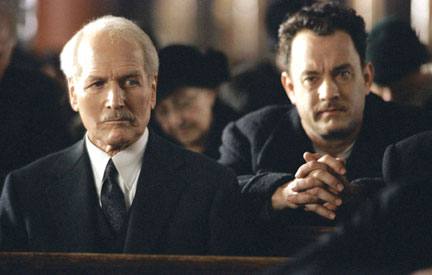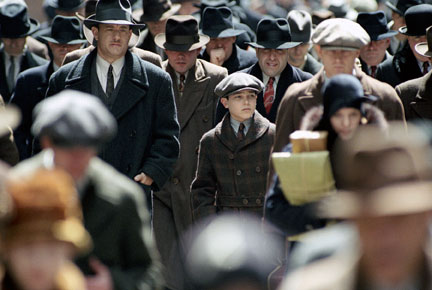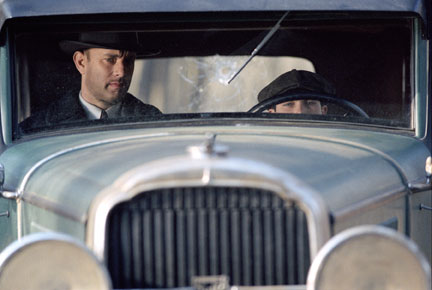Edge of the Screen
VideoScope #43: The Long and Winding "Road to Perdition"
By Max Allan Collins

The readers of VideoScope can appreciate better than most the sweet irony of my situation not so long ago—for a few weeks, I was negotiating with Richard and Dean Zanuck, with a DreamWorks film in the offing, for the rights to my graphic novel, "Road to Perdition"; and at the same time—just a "call waiting" click away—negotiating the distribution of my indie film "Real Time: Siege at Lucas Street Market" with Lloyd Kaufman and Michael Herz of Troma. Situated as I am, in Muscatine, Iowa—virtually the center of our great land—I felt for one brief shining moment that I had become the nexus of show business. The West Coast, in all its Hollywood studio glory, and the East Coast, in all its shabby indie splendor, had collided somehow, and crash—landed in flyover country.
As frequent readers of this magazine may recall, I am a longtime mystery writer who in recent years has involved himself in indie filmmaking. After a rocky but instructive ride as the screenwriter of the Jeff Speakman/James Brolin action picture "The Expert" (without which Cinemax would be sorely pressed for product), I managed to put together the thriller "Mommy," which ran on Lifetime as a Movie of the Week and got picked up by the Blockbuster chain. A sequel followed, so did a documentary on Mickey Spillane, and, most recently, "Real Time," a movie designed for DVD (the first 100% multi—angle feature...at least that isn't porno) and available, yes, from Troma.

Now one of my works has been adapted for the screen in a DreamWorks feature starring Tom Hanks, Paul Newman, Jude Law, Jennifer Jason Leigh, Stanley Tucci and other people I could never in a million years afford for one of my indies. The director (apparently the Zanucks didn't realize I was available) is Sam Mendes, following his Oscar win for "American Beauty." I was not asked to write the screenplay, but David Self did an intelligent and faithful job, aided by several gifted (uncredited) screenwriters, one of them a famous British playwright brought in by Mendes. "Road to Perdition" was attractive to Hollywood in part because of the lovely art by Richard Piers Rayner—Steven Spielberg, who greenlighted the project after Richard Zanuck showed him the graphic novel, reportedly said, "Great! I don't even have to storyboard it!" But the gifted director of "Jaws" and (my favorite) "1941" is also said to have been attracted by the strong father—and—son story at the heart of this violent tale.
The graphic novel came to be written in a rather offhanded fashion. I had just been fired from my longtime (15 years) gig as the writer of the "Dick Tracy" strip, supposedly because I had been caught up in the "True Crime" trading cards scandal (with George Hagenauer, I wrote the "guns and gangsters" series), but really because I had told my obnoxious new editor at Tribune Media Services to go f*ck himself. Mysteriously bereft of my main comics gig, suddenly, I took a meeting (they say this in comics as well as movies) with DC editor Andy Helfer at a comics con. Andy was planning to do a line of crime/mystery graphic novels and wanted me to write one—specifically, he wanted something along the lines of my Nathan Heller novels, in which my tough '30s/'40s—era P.I. takes on famous cases like the Lindbergh kidnapping, the Huey Long assassination and the Black Dahlia murder.
But Andy didn't want Nate Heller: he wanted no existing series characters; this had to be strictly a new property, albeit building on my old premise of "true—crime" fiction. So, off the top of my head, I pitched him an idea I'd been noodling with...I wanted to do in comics what I was seeing in Asian action flicks, specifically the then—cultish John Woo movies (this was '94, when VHS tapes were being passed around among buffs). Woo had done a Vietnam—era war movie in tribute to the classic Japanese manga "Lone Wolf and Cub" (which of course had spawned half a dozen wonderful movies, plus the American re—edited oddity, "Shogun Assassin"). I had in mind something set in the America of 1929, with a gangland enforcer as my American samurai.

A significant sidebar: researching the first Nathan Heller novel ("True Detective," 1983), I had run across material on John Looney, the Irish godfather of 1920s—era Rock Island, Illinois. Looney had a homicidal son named Connor, and published a sleazy blackmail—based tabloid, and he and his psycho son were involved in wild shoot—outs and were Capone cronies to boot. In addition, Looney betrayed a loyal lieutenant, and Crazy Connor blew away another former crony, St. Valentine's Day—style. I thought the Looney story would be perfect for the true—crime element of my graphic novel. Also, in the second Heller novel ("True Crime," 1984), I had explored both the urban world of gangsters like Nitti and Capone and the rural landscape of outlaws like Pretty Boy Floyd and John Dillinger. Movies and novels usually focused on one or the other—gangsters or outlaws—but my research made clear that this was one criminal world. Baby Face Nelson had been a Capone man, for instance. Frank Nitti was Ma Barker's landlord. So another goal of "Road to Perdition" would be to combine the Capone/Nitti world with that of Bonnie and Clyde.
My American samurai would be Michael O'Sullivan, a good family man who is betrayed by his "shogun," John Looney. O'Sullivan's older of two young sons witnesses a mob execution, and a betrayal follows, which sends the father and his adolescent son out on a road of vengeance, even as they hope to reach the salvation of a family farm at Perdition, Kansas. The dynamic of a father and his coming—of—age adolescent son is perhaps the major departure from the "Lone Wolf/Baby Cart" homage. I have not seen the movie yet, as I write this; but I am intimate with the screenplay, having been hired to write a novelization of this adaptation of my own work (!).
Second significant sidebar: the first novelization I wrote was for "Dick Tracy," the Warren Beatty film; I'd been a consultant on the feature, and was still the writer of the strip. That book was quite successful, and—after I was fired from the "Tracy" strip—I let it be known I was available to do other "movie tie—ins." Since then, it's been a profitable sideline. Among the movie novels I've written are "In the Line of Fire," "Air Force One," "Maverick," "Waterworld," both "Mummy"s (and "The Scorpion King"), "Windtalkers" and (for Dreamworks) the "New York Times"—bestselling "Saving Private Ryan." I've also written original novels from TV shows, including "NYPD Blue," "CSI" and "Dark Angel."
The graphic novel will be reprinted—by both Pocket Books and DC comics—but Dream—Works also wanted a prose version, and I was given the opportunity to write it. Frankly, it was frustrating: I was restricted to the events and dialogue of the screenplay; but I was able to flesh out the interior lives of the characters and provide historical background in a way only the originator of the material could do. It's a strong novelization, and I hope you'll read it...but I also hope you'll read the graphic novel. Thankfully, the screenplay is both good and faithful. Much was left out, of course—the graphic novel was 300 pages long, and episodic (though never published that way, "Road" was intended by DC Comics to be serialized in three manga—like volumes).
A major difference is my more violent take on this material—I essentially wrote a John Woo movie, but they wanted to do "The Godfather" instead...which is cool. I like "The Godfather." Amusingly, the name Looney—which attracted me to this historical figure in the first place—was deemed too "comic—booky," and now Paul Newman plays John Rooney. Michael O'Sullivan was changed to Sullivan; Perdition, Kansas, became Perdition, Michigan. The only real twinge I get is from the omission of my ending...actually, my coda. You'll find it in my graphic novel, which is published in two forms—movie poster cover, and Richard Piers Rayner's original cover (collect them all!).
My wife Barb—line producer on "Real Time," production manager on my other features—accompanied me to the "Perdition" set in Chicago last July. A vast armory on the South Side had been converted into a soundstage. It was very dark, gloomy, with an elaborate set built up off the ground that was the Rooney/Looney mansion's downstairs, and another that was the upper middle—class Sullivan home. Barb and I were there all day—10 or 11 hours—and were amazed by how similar it was to our own low—budget indie sets. Of course, the food was better—I would say the food service and craft service costs, for the day we were there, could have funded my next indie. But the process was the same. About all that was missing was that ticking—clock indie hysteria.
Richard Zanuck and his son Dean—the producers—were wonderful to us. Richard Zanuck spent most of the day with us, and shared anecdotes about "Jaws," "Butch Cassidy and the Sundance Kid" and even "Compulsion" (I had brought a laserdisc jacket of that, his first feature, for him to sign). He and Dean (whose first producer credit this is) showed us around the sets; the boyish enthusiasm Richard Zanuck revealed indicates why he has lasted so long: the man loves movies. We did not meet Paul Newman. We were close to him...close enough to touch him. But he was swept on and off the set like the President, and while on set, he was focused and intensely professional... friendly to cast and crew, but working very hard, a precision craftsman.
Jennifer Jason Leigh was friendly and sweet and rather shy, a delight. Tom Hanks was a larger—than—life figure, friendly but imposing...he spoke to me several times, but I rarely responded. Responses simply weren't called for. "Barb," I said to my wife at one point, "I'm in a Tom Hanks movie...and I don't have any lines!" Director Sam Mendes spent 10 minutes with me, and was warm and friendly. On set, he was clearly in control, but cinematographer Conrad Hall got all the time he wanted and needed. I was frustrated by the slow pace—I didn't find it boring (I was fascinated...I love being on a movie set), but seeing five set—ups happen in 10 hours was disconcerting. In my shabby little world, if we did less than 20 set—ups in a day, we'd be out of business!
People ask me: Has it hit you? Well, not really...but once, walking back from craft services with a can of Coke, heading to where Dick and Dean Zanuck waited, I saw the scores of extras in period costume, and the huge sets, in the cavernous armory—cum—soundstage. And I was suddenly very glad I'd told that Tribune Media Services editor to go f*ck himself.*